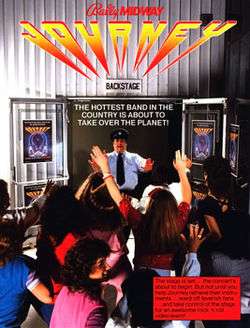Journey (1983 video game)
| Journey | |
|---|---|
|
Arcade flyer for Journey | |
| Developer(s) | Bally Midway |
| Publisher(s) | Bally Midway |
| Designer(s) | Marvin Glass and Associates |
| Programmer(s) | Richard Ditton, Elaine Ditton |
| Artist(s) | Scott Morrison |
| Composer(s) | Elaine Ditton, Steve Meyer |
| Platform(s) | Arcade |
| Release date(s) | |
| Genre(s) | Action |
| Mode(s) | Single-player |
Journey is an arcade game released by Bally Midway in 1983. Rock band Journey had enjoyed major success in the early 1980s, and Bally/Midway decided to ride this wave of popularity by creating an arcade game based on the group. Its release was intended to coincide with a US tour by the band.
This game features digitized photographs of the members of the band at the time of release: Steve Perry, Neal Schon, Steve Smith, Jonathan Cain and Ross Valory.
Gameplay
The objective of Journey is to reunite the members of the band with their instruments (and singer Steve Perry with his microphone). Each instrument is located on a different planet, and the musician must first reach the instrument, then make it back to the band's ship without running into an obstacle. Each musician's stage presents a different challenge.
Once all of the instruments have been collected, the band performs a concert while the player controls Herbie, a bouncer whose job is to prevent fans from rushing the stage. Once a fan sneaks past the bouncer, the crowd steals the band's instruments, and the player must reacquire the instruments again in harder versions of the previous planet challenges. The game continues in this fashion until the player has lost all of his or her lives.
Journey features digitized photographs of each band member's head (placed on a cartoon body), as well as a looping excerpt from the band's hit song "Separate Ways (Worlds Apart)", played by a cassette player inside the cabinet.
Development
Although they have cartoon bodies, the faces of the members are shown as black-and-white photographs, taken of the band while on tour. The photo technology was originally to be used in another game, which would take photos for the high scores. However, the game in question failed location testing when one player engaged in exhibitionism, flashing the camera.[2]
Reception
In its June 2007 issue, Game Informer magazine named the game number 9 on its "Top 10 Worst Licensed Game Ideas (ever)".
See also
Journey Escape - An unrelated game based on the band released for the Atari 2600 in 1982.
References
- ↑ http://www.arcade-history.com/?n=journey-upright-model-no.-358&page=detail&id=1227
- ↑ Kent, Steven L. (2001). The Ultimate History of Video Games. Roseville, California: Prima Publishing. pp. 174–175. ISBN 0-7615-3643-4.
